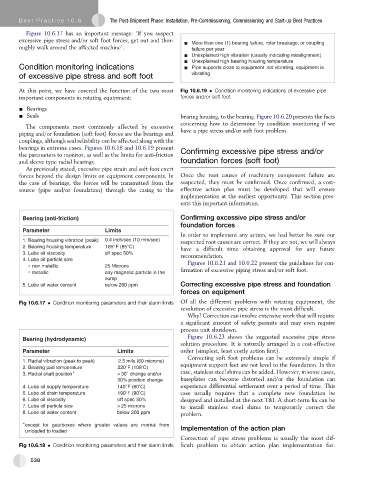Page 567 - Subyek Teknik Mesin - Forsthoffers Best Practice Handbook for Rotating Machinery by William E Forsthoffer
P. 567
Be st Practice 1 0.6 The Post-Shipment Phase: Installation, Pre-Commissioning, Commissioning and Start-up Best Practices
Figure 10.6.17 has an important message: ‘If you suspect
excessive pipe stress and/or soft foot forces, get out and thor- - More than one (1) bearing failure, rotor breakage, or coupling
oughly walk around the affected machine’. failure per year
- Unexplained high vibration (usually indicating misalignment)
- Unexplained high bearing housing temperature
Condition monitoring indications - Pipe supports close to equipment not vibrating, equipment is
of excessive pipe stress and soft foot vibrating
At this point, we have covered the function of the two most Fig 10.6.19 Condition monitoring indications of excessive pipe
important components in rotating equipment: forces and/or soft foot
- Bearings
- Seals bearing housing, to the bearing. Figure 10.6.20 presents the facts
concerning how to determine by condition monitoring if we
The components most commonly affected by excessive
piping and/or foundation (soft foot) forces are the bearings and have a pipe stress and/or soft foot problem.
couplings, although seal reliability can be affected along with the
bearings in extreme cases. Figures 10.6.18 and 10.6.19 present Confirming excessive pipe stress and/or
the parameters to monitor, as well as the limits for anti-friction
and sleeve type radial bearings. foundation forces (soft foot)
As previously stated, excessive pipe strain and soft foot exert
forces beyond the design limits on equipment components. In Once the root causes of machinery component failure are
the case of bearings, the forces will be transmitted from the suspected, they must be confirmed. Once confirmed, a cost-
source (pipe and/or foundation) through the casing to the effective action plan must be developed that will ensure
implementation at the earliest opportunity. This section pres-
ents this important information.
Bearing (anti-friction) Confirming excessive pipe stress and/or
foundation forces
Parameter Limits
In order to implement any action, we had better be sure our
1. Bearing housing vibration (peak) 0.4 inch/sec (10 mm/sec) suspected root causes are correct. If they are not, we will always
2. Bearing housing temperature 185°F (85°C) have a difficult time obtaining approval for any future
3. Lube oil viscosity off spec 50%
recommendation.
4. Lube oil particle size Figures 10.6.21 and 10.6.22 present the guidelines for con-
non metallic 25 Microns
firmation of excessive piping stress and/or soft foot.
m c i l l a t e a n y m a g n c i t e p e l c i t r a n i h t e
sump
5. Lube oil water content below 200 ppm Correcting excessive pipe stress and foundation
forces on equipment
Fig 10.6.17 Condition monitoring parameters and their alarm limits Of all the different problems with rotating equipment, the
resolution of excessive pipe stress is the most difficult.
Why? Correction can involve extensive work that will require
a significant amount of safety permits and may even require
process unit shutdown.
Figure 10.6.23 shows the suggested excessive pipe stress
Bearing (hydrodynamic)
solution procedure. It is naturally arranged in a cost-effective
Parameter Limits order (simplest, least costly action first).
Correcting soft foot problems can be extremely simple if
1. Radial vibration (peak to peak) 2.5 mils (60 microns)
°
°
2. Bearing pad temperature 220 F (108 C) equipment support feet are not level to the foundation. In this
) case, stainless steel shims can be added. However, in some cases,
°
3. Radial shaft position > 30 change and/or
30% position change baseplates can become distorted and/or the foundation can
4. Lube oil supply temperature 140 F (60 C) experience differential settlement over a period of time. This
°
°
5. Lube oil drain temperature 190 F (90 C) case usually requires that a complete new foundation be
°
°
. 6 L u b e l i o s i v c o y t i s f f o s p e c 5 0 % designed and installed at the next T&I. A short-term fix can be
7. Lube oil particle size > 25 microns to install stainless steel shims to temporarily correct the
8. Lube oil water content below 200 ppm problem.
)
except for gearboxes where greater values are normal from
unloaded to loaded Implementation of the action plan
Correction of pipe stress problems is usually the most dif-
Fig 10.6.18 Condition monitoring parameters and their alarm limits ficult problem to obtain action plan implementation for.
538

